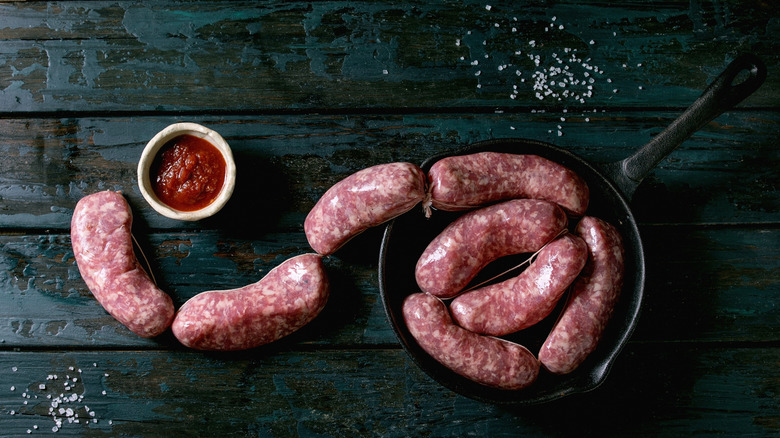What Are Sausage Casings And Should You Remove Them?
Even commonplace foods can have a bit of intrigue. For example, take sausages and their mysterious casings, that skin-like material that holds the meat and other ingredients together. Are they edible? Should they be removed? What are they made of? To answer your burning sausage-based questions, we caught up with Glenn Rolnick of Carmine's Italian Restaurant at the Nassau Paradise Island Wine & Food Fest, and the chef provided some seasoned answers during our exclusive chat. As explained by Rolnick, not all sausage casings are natural, and whether the casing is natural or synthetic determines if it should be removed.
"They make [sausage] casings that aren't natural that will not break down the same," Rolnick explains. The chef is referring to synthetic or artificial casings, which can consist of materials like plastic, collagen, or cellulose. Conversely, natural casings are made from the intestines of animals, often pigs and cows, although sheep and goat intestines can also be used. "You really have to know if it is the intestine because that is the best one to eat," Rolnick says, as sausages with natural casings are "the most tender."
Consequently, it's important to know what type of casing is on your sausage. Rolnick recommends removing artificial casings before eating. Removing plastic casings is a no-brainer, but cellulose casings should also be removed, even though they're derived from plants, because of their thick, chewy consistency. Collagen is a bit trickier since these casings can be edible or inedible. In this case, you can let the thickness of the casing guide your decision.
Best practices for removing sausage casings
In the event you want to remove casings when making one of our 36 sausage recipes you must try (such as one-pot jambalaya), Glenn Rolnick offers some tips on how — and when — to do so. The chef says when you remove the casing largely depends on the dish you're preparing. "[With] something that you're going to break [the sausage] apart anyway, I would take [the casing] off ahead of time," Rolnick explains. In this case, Rolnick says to "squeeze [the sausage] out, adding, "It squeezes like a balloon kind of thing." For example, this 30-minute sausage ragu recipe calls for the meat to be broken up in the pot as it cooks, requiring the casing to be removed. With other preparations, Rolnick says that "you can always peel [the casing] off after you cook it."
While sustainable kitchen practices are always a good thing, Rolnick tells us there isn't much you can do with a removed natural sausage casing. As explained by the chef, "Even if you made it really crispy and even if you cut it up, it still comes out a little bit on the chewier side." If you want to cut back on food waste, Rolnick suggests getting ground meat from the butcher instead.

